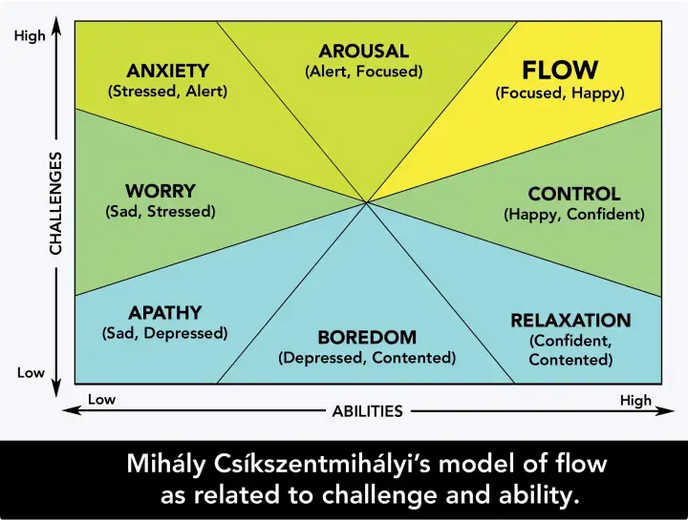What Prevents Flow at Work
Introduction
Unfortunately, most people are either bored or stressed at work; with only a few experiencing Flow.
NB Employees engagement is directly tied to productivity and job satisfaction; productivity is not the same as being busy.
The 2 main barriers to experiencing Flow at work are multitasking and stress.
i) Multitasking
Our mental resources are limited.
Multitasking involves
"...frequent switching between tasks cost us on an average as much as 40% of our productivity..."
G. Weinberg as quoted by Beata Souders, 2019
"...we should be more concerned with where we place our attention as a tendencies toward rumination and living on autopilot are blocks that prevent us from entering flow..."
Mihaly Csikszentmihalyi as quoted by Beata Souders, 2019
Activities like addiction to electronic and social media, mobile phones, etc are obstacles to finding Flow.
We need to align focus or attention (psychic energy) with time and habits.
"...what we focus on determines our reality as the information we take in ultimately adds to the content and quality of our consciousness and our lives......focus is important......the levels of stress we experience are amenable to the control of attention..."
Mihaly Csikszentmihalyi as quoted by Beata Souders, 2019
ii) Stress
(for more detail, see elsewhere in Knowledge Base)
There is both positive (eustress) and negative stress (distress); it can be used as a motivator.
The keys to understanding stress:
"...- understand the difference between stress that is destructive vs constructive
- be able to live with both (because we need challenges......to master hardships and to develop perseverance), and
- learn to shift one's perspective from a negative to positive, both as an individual as well as within an organisation..."
Oystein Sasvik as quoted by Beata Souders, 2019
NB Challenges are inevitable; however, it is how we respond to them that makes all the difference.
"...people are less motivated by trying to avoid stress and harnessing it towards a meaningful ends and seeing stress is an opportunity to rise to the occasion..."
Kelly McGonigal as quoted by Beata Souders, 2019
The below diagram represents the balance between challenge and skills necessary for experiencing Flow
At the right end of the curve, less challenging tasks with low work demands causes distress and boredom; at the other end of the curve, stress is characterised by tasks that too challenging and work demands is too high; while the top of the curve is where moderate work demands and moderately challenging task causes maximum eustress.
In a high tension/arousal/anxiety area is when our emotional state has hijacked the rational part of the brain, ie prefrontal cortex. Whenever you are upset, the brain focuses, ie in a constructive worry will help you find a solution. The brain will work on this problem until it solves, ie rumination.
There are hindrances and challenges around job demands
"...hindrances and challenges where one leads to the experience of job demands as strain and the others can trigger to enter the state of flow and focusing one's attention on the task..."
Jeffrey Dahlke as quoted by Beata Souders, 2019
Adequate resources an appropriate challenges create high engagement.
"...higher workload produced more flow experiences, and further prevented burnout when enough resources were present..."
Jeffrey Dahlke as quoted by Beata Souders, 2019
Flow needs both an innovative learning climate and social capital.
Even though positive and negative stress can exist side by side they are caused by different triggers
Also, it has been suggested that
"...fight and flight response is not the same as arousal created by a sense of challenge when we experience an adrenaline rush that mobilises our mental energy into a focused effort..."
Oystein Sasvik as quoted by Beata Souders, 2019
Furthermore, it has been found
"...a variance in the heart rate between those who exerts mental effort toward a meaningful task and those who feel threatened and compelled to act out of fear or avoidance of consequences..."
Oystein Sasvik as quoted by Beata Souders, 2019
However, some degree of distress can serve a purpose.
"...strain is viewed as a necessary motivator, even though it may be experienced as unpleasant.....Both types of stress are necessary in specific contexts to motivate action, to develop the awareness that allows us to distinguish between different types of stress, and finally to develop resilience......building social capital through cultivating high-quality relationships is also a great way to address individual and group resilience to stress..."
Oystein Sasvik as quoted by Beata Souders, 2019
A collaborative effort to handle stress, addressing negative feelings, etc can be effective, ie see stress as a mutual challenged to be addressed as part of the organisational environment.
